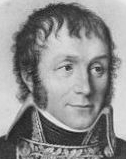General Louis Joseph Lahure

Born: December 29, 1767
Place of Birth: Mons, Belgium
Died: October 24, 1853
Place of Death: Wavrechain-sous-Faulx, France
Arc de Triomphe: LAHURE on the south pillar
Pronunciation:
A student at the university of Louvain, Louis Joseph Lahure took part in the Belgian revolution of 1787 as a volunteer. He joined the regiment of Hainaut and was named a sous-lieutenant, but as the revolution was crushed he took refuge in France at Lille in 1790. In April of 1792 Lahure was named a lieutenant in the Belgian legion in the service of France and then two months laters he was promoted to capitaine. Serving with the Army of the North, he served under Luckner at the attack of Courtrai in June and then he served at the defense of Lille in September and October. Lahure next joined the advance guard of Bourdonnaye and he served at the action of the citadel of Antwerp in November. Ordered to organize Belgian battalions at Brussels, Lahure was then promoted to chef de bataillon in January of 1793. Two months later he served under Dampierre at Neerwinden and then in May he served at Valenciennes and the retreat of the camp of Famars. That August Lahure served at the retreat of the camp of César and then the raising of the siege of Dunkirk. In September he fought at the Battle of Hondschoote and then in October he served at the Battle of Wattignies .
1794 was a busy year for Lahure and he started it by being placed in charge of the 3rd Belgian Battalion of Chasseurs-Tirailleurs in the Army of the North. Next he took command of the advance guard of General Souham's division and in April he fought at Mouscron. In May Lahure served at Courtrai and Tourcoing and then in June he served at Roulers and then Deynze where he took 300 prisoners. The next month he seized Malines and then in September he served at Boxtel. From October to December Lahure served at the siege of Grave. In January of 1795 he crossed the Waal on the ice as it had frozen over, and he entered Utrecht and then Amsterdam and then seized Haarlem and Alkmaar. On January 23rd, with a company and squad of hussars, Lahure led his cavalry in capturing the Dutch fleet at Texel which was frozen in the ice. They approached over the ice and captured the fleet of fourteen vessels without a shot being fired.
In June of 1795 Lahure was sent to the Army of the Sambre and Meuse and the next month he was promoted to chef de brigade of the 1st demi-brigade of tirailleurs in Grenier's division. In September he fought at the action of Dusseldorf and then in May of 1796 he took command of the 15th Light as part of Bernadotte's division. Lahure and his men served at the blockade of Mainz and then the combat of Altenkirchen. In 1797 Bernadotte's division was sent to reinforce the Army of Italy and Lahure and his men went too. In March Lahure served at the crossing of the Tagliamento and the action of Gradisca and then he occupied the mines of Idria. Remaining in Italy, in 1798 he was organized into part of Rey's division in the Army of Rome and later he served in Kellermann's brigade. In December of that year Lahure won at Rignano and then he served at Monte Alto. The next month he fought at the action of Naples and then in June of 1799 he served at the Trebbia where his left leg was shattered by a ball. Lahure was taken prisoner by the Russians and transported to Piacenza to recover. Released on parole by Austrian General Melas, he was then promoted to général de brigade by General Macdonald. However, his wound left him somewhat crippled and he did not return to the army.
In March of 1802 Lahure joined the Corps Législatif as a deputy of the département of Jemappes. He served in this position until the end of 1813. In the meantime he was named a Commander of the Legion of Honor in 1804 and in 1807 he briefly returned to the army to command the 5th Legion of the Reserve at Grenoble. Two years later in 1809 he was named commander of the département of Nord and he became Rampon's chief of staff of the Army of the Scheldt. Before the end of the year Lahure returned to his position in the Corps Législatif. Lahure joined the imperial nobility during this time too, being named a Knight of the Empire in 1811 and a Baron of the Empire in 1813. In October of 1813 he took command of the département of Nord.
After Napoleon's abdication and the Bourbon Restoration, Lahure was naturalized as a French citizen. When Napoleon returned from exile to resume power for the Hundred Days, he placed Lahure in charge of the département of Nord and then commander of Douai. In July when Lahure was initially called upon to surrender the city and his command he refused. In August of 1815 he was put on non-activity.
Bibliography
- Divry, Arnauld. Les Noms Gravés sur l'Arc de Triomphe. Paris: L'Harmattan, 2017.
- Six, Georges. Dictionnaire Biographique des Généraux & Amiraux Français de la Révolution et de l'Empire (1792-1814). 2 vols. Paris: Gaston Saffroy, 2003.
Updated February 2018
© Nathan D. Jensen